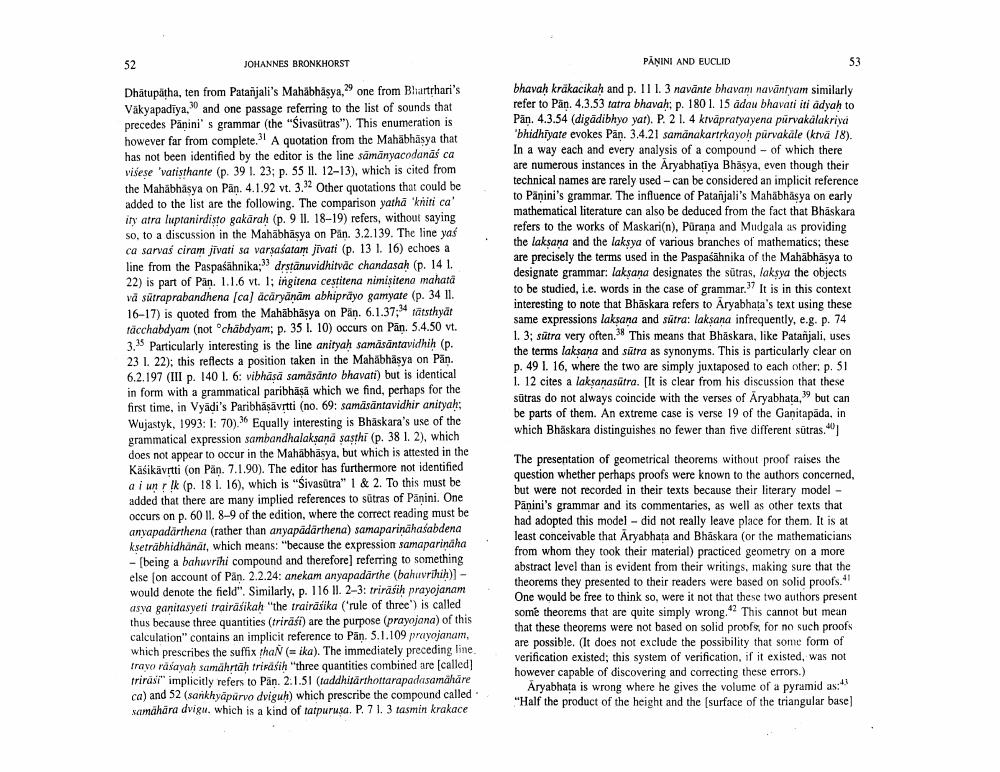Book Title: Panini And Euclid Reflections On Indian Geometry Author(s): Johannes Bronkhorst Publisher: Johannes Bronkhorst View full book textPage 6
________________ 52 JOHANNES BRONKHORST Dhatupatha, ten from Patanjali's Mahabhäsya,29 one from Bhartṛhari's Vakyapadiya,30 and one passage referring to the list of sounds that precedes Panini's grammar (the "Sivasütras"). This enumeration is however far from complete.31 A quotation from the Mahabhāṣya that has not been identified by the editor is the line samanyacodanās ca visese 'vatisthante (p. 39 1. 23; p. 55 11. 12-13), which is cited from the Mahabhasya on Pän. 4.1.92 vt. 3.32 Other quotations that could be added to the list are the following. The comparison yatha 'kniti ca' ity atra luptanirdisto gakāraḥ (p. 9 11. 18-19) refers, without saying so, to a discussion in the Mahabhäṣya on Pän. 3.2.139. The line yas ca sarvas ciram jivati sa varsaśatam jivati (p. 13 1. 16) echoes a line from the Paspaśähnika;33 drstänuvidhitväc chandasaḥ (p. 14 1. 22) is part of Pan. 1.1.6 vt. 1; ingitena cestitena nimișitena mahatä vä sütraprabandhena [ca] äcäryäṇām abhipräyo gamyate (p. 34 11. 16-17) is quoted from the Mahabhäṣya on Pän. 6.1.37:34 tätsthyät täcchabdyam (not chabdyam; p. 35 l. 10) occurs on Pän. 5.4.50 vt. 3.35 Particularly interesting is the line anityaḥ samäsäntavidhiḥ (p. 23 1. 22); this reflects a position taken in the Mahabhäṣya on Pän. 6.2.197 (III p. 140 1. 6: vibhāṣā samäsänto bhavati) but is identical in form with a grammatical paribhāṣā which we find, perhaps for the first time, in Vyadi's Paribhāṣāvṛtti (no. 69: samäsäntavidhir anityah: Wujastyk, 1993: I: 70).36 Equally interesting is Bhaskara's use of the grammatical expression sambandhalakṣaṇā ṣasthi (p. 38 1. 2), which does not appear to occur in the Mahabhäṣya, but which is attested in the Käsikävṛtti (on Pän. 7.1.90). The editor has furthermore not identified a i un rlk (p. 181. 16), which is "Śivasutra" 1 & 2. To this must be added that there are many implied references to sutras of Panini. One occurs on p. 60 11. 8-9 of the edition, where the correct reading must be anyapadarthena (rather than anyapädärthena) samaparinähaśabdena kṣeträbhidhänät, which means: "because the expression samaparinäha - [being a bahuvrihi compound and therefore] referring to something else (on account of Pän. 2.2.24: anekam anyapadarthe (bahuvrihih)] - would denote the field". Similarly, p. 116 11. 2-3: trirašiḥ prayojanam asya ganitasyeti trairäsikaḥ "the trairäsika ('rule of three') is called thus because three quantities (triräsi) are the purpose (prayojana) of this calculation" contains an implicit reference to Pän. 5.1.109 prayojanam, which prescribes the suffix thaN (= ika). The immediately preceding line. trayo rasayaḥ samährtäḥ trisäsih "three quantities combined are [called] trirasi implicitly refers to Pan. 2:1.51 (taddhitärthottarapadasamahāre ca) and 52 (sankhyapurvo dviguḥ) which prescribe the compound called⚫ samahāra dvigu. which is a kind of tatpurusa. P. 7 1. 3 tasmin krakace PANINI AND EUCLID bhavaḥ kräkacikaḥ and p. 111. 3 navante bhavam navantyam similarly refer to Pāṇ. 4.3.53 tatra bhavaḥ, p. 180 1. 15 adau bhavati iti adyaḥ to Pan. 4.3.54 (digädibhyo yat). P. 2 1. 4 ktväpratyayena purvakälakriya 'bhidhiyate evokes Pān. 3.4.21 samanakartṛkayoḥ purvakäle (ktvä 18). In a way each and every analysis of a compound of which there are numerous instances in the Aryabhatiya Bhasya, even though their technical names are rarely used - can be considered an implicit reference to Panini's grammar. The influence of Patanjali's Mahabhāṣya on early mathematical literature can also be deduced from the fact that Bhaskara refers to the works of Maskari(n), Pürana and Mudgala as providing the lakṣaṇa and the lakṣya of various branches of mathematics; these are precisely the terms used in the Paspasähnika of the Mahabhāṣya to designate grammar: lakṣana designates the sutras, lakṣya the objects to be studied, i.e. words in the case of grammar." It is in this context interesting to note that Bhaskara refers to Aryabhata's text using these same expressions lakṣaṇa and sutra: lakṣaṇa infrequently, e.g. p. 74 1. 3; sutra very often.38 This means that Bhaskara, like Patanjali, uses the terms lakṣaṇa and sutra as synonyms. This is particularly clear on p. 49 1. 16, where the two are simply juxtaposed to each other: p. 51 1. 12 cites a lakṣaṇasutra. [It is clear from his discussion that these sūtras do not always coincide with the verses of Aryabhata,39 but can be parts of them. An extreme case is verse 19 of the Ganitapada, in which Bhaskara distinguishes no fewer than five different sutras."] 53 The presentation of geometrical theorems without proof raises the question whether perhaps proofs were known to the authors concerned, but were not recorded in their texts because their literary model - Panini's grammar and its commentaries, as well as other texts that had adopted this model - did not really leave place for them. It is at least conceivable that Aryabhata and Bhaskara (or the mathematicians from whom they took their material) practiced geometry on a more abstract level than is evident from their writings, making sure that the theorems they presented to their readers were based on solid proofs." One would be free to think so, were it not that these two authors present some theorems that are quite simply wrong.42 This cannot but mean that these theorems were not based on solid proofs, for no such proofs are possible. (It does not exclude the possibility that some form of verification existed; this system of verification, if it existed, was not however capable of discovering and correcting these errors.) Aryabhata is wrong where he gives the volume of a pyramid as:43 "Half the product of the height and the [surface of the triangular base]Page Navigation
1 ... 4 5 6 7 8 9 10 11 12 13 14 15 16 17 18 19 20
